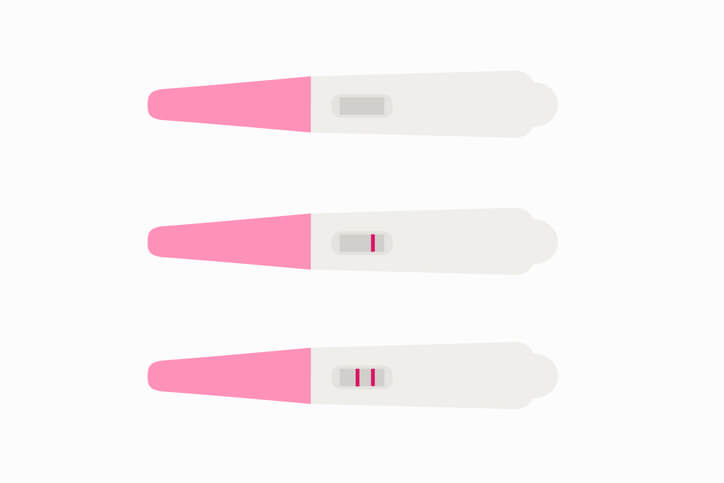Missing your period is one of the most reliable signs of pregnancy.
Whether or not you’re trying to conceive, realizing that your period is late can be a moment of great stress, excitement, or both.
Of course, there are many other potential causes of missing your period.
To confirm if you are, in fact, pregnant, you may choose to take a home pregnancy test.
One popular pregnancy test is sold under the brand name Clearblue.
These home tests are said to be 99% accurate. Plus, they come in a variety of options, some of which even have extra features like early detection.
Depending on which Clearblue pregnancy test you take, it may not be super clear what the results are.
This guide from PregnancyResource.org goes over the different types of Clearblue pregnancy tests and how you can read their results accurately.
3 Signs You Should Take a Pregnancy Test
If you’re trying to have a baby, then pregnancy tests might be a regular part of your life.
After all, you might not want to wait until you experience pregnancy symptoms to discover the good news.
However, for others, there are a few signs that warrant taking a pregnancy test. Here are three reasons why you may want to use a pregnancy test:
- Your contraceptives fail: There are many ways to protect yourself from an unplanned pregnancy, including hormonal birth control, spermicide, copper IUD, and many others — with condoms remaining one of the most popular options. If your condoms or other forms of birth control fail, you should generally take a pregnancy test about two weeks after the event to rule out pregnancy.
- You miss your period: There are many reasons why your period may be late, which include high stress levels, excessive physical exercise, and even travel. However, a missed period can also be a sign of pregnancy. If several days pass since your period was supposed to start, then a pregnancy test may be in order.
- You feel nauseous: If you feel nausea (AKA morning sickness) for several days without any other explanation for it, then pregnancy may be the culprit because of hormonal changes that begin in early pregnancy. Taking a pregnancy test can help you confirm if pregnancy is what’s causing your morning sickness.
When To Take a Pregnancy Test
A pregnancy test detects levels of a hormone called human chorionic gonadotropin (hCG).
This hormone helps your body to thicken the uterine lining, preparing it to hold and protect the fetus for the coming nine months.
HCG begins to develop soon after the fertilized egg implants itself in the uterus (about 10 days after conception).
However, if you test early, there may not be detectable levels of hCG in your body, and a pregnancy test may not detect that you’re pregnant.
For the most accurate results, it’s best to resist testing early, and to wait until after your first missed period.
This will give your body plenty of time to build up hCG levels. This way, a pregnancy test will easily detect the hormone in your urine and provide clear results.
You’ll have a better chance of getting the correct pregnant result the first time, so you don’t have to take another one out of uncertainty.
How Do You Use a Clearblue Pregnancy Test?
Taking a Clearblue pregnancy test is fairly straightforward. However, there may be some differences depending on which type of test kit it is.
There are several types of Clearblue pregnancy tests:
- Clearblue Early Detection Pregnancy Test
- Clearblue Rapid Detection Pregnancy Test
- Clearblue Flip & Click Pregnancy Test
- Clearblue Digital Pregnancy Test
- Clearblue Combo Pack Pregnancy Test
There are only small differences between how you should take the above tests. In general, they should have a similar procedure for you to follow, which includes the following:
- Remove the test stick from the wrapper.
- Take the cap off the test stick.
- Dip the tip of the test stick into a container with your urine for about 5 seconds.
- If you prefer, you can pee on the tip of the test stick for about 5 seconds.
- Make sure the tip of the test stick is pointed downwards the whole time.
- Lay the stick on a flat surface for about 3 minutes.
- Read the results.
How To Read Clearblue Pregnancy Test Results
After you miss your expected period and take your Clearblue pregnancy test, it’s time to wait for the results. How long you wait depends on which test you take.
Some Clearblue tests have a waiting time of three minutes, while other Clearblue tests will get you results in less than one minute.
Some tests even come with a smart countdown, which tells you how much time is left until your test results are ready.
If you use a Clearblue digital pregnancy test, then the results will be clearly displayed for you.
After waiting the designated amount of time, you should see either “pregnant” or “not pregnant” displayed in the results window on the test stick.
A Clearblue rapid detection pregnancy test uses a color change tip that collects a sample from your urine stream, and a control window to show the test worked.
If you use a non-digital test, then the results may not be as clear to read.
Non-digital Clearblue pregnancy tests use the classic vertical lines display to show you if you have a positive result or not. A faint line could mean you are pregnant even though it’s hard to see.
If you are not pregnant, then only one vertical line should appear on the pregnancy test.
However, if you are pregnant, then a second vertical line should appear next to the original one. The “positive” line will be a much darker or brighter color than the first one.
In Conclusion
If you miss your period, experience morning sickness, or had your contraception fail, then taking a pregnancy test might give you the peace of mind you need in either direction.
Clearblue is a popular brand for pregnancy tests and offers many test options, like their Early Detection Pregnancy Test, Rapid Detection Pregnancy Test, or Digital Pregnancy Test.
If you’re taking a digital test, then the results will be clearly written out for you.
If you’re taking a non-digital test, then a second vertical line on the display is a sure sign that you’re pregnant.
If your pregnancy test comes out positive, make sure to schedule a physical exam with your healthcare provider as soon as possible to schedule a doctor’s urine test or blood test to make sure that your and your baby’s health are in top shape from day one of your pregnancy.
References and Sources:
Factors Associated with Menstrual Cycle Irregularity and Menopause | PMC
Nausea and Vomiting of Pregnancy | PMC
Human Chorionic Gonadotropin: Hormone, Purpose & Levels | Cleveland Clinic

Bridget Reed is a Tampa-based content development manager, writer, and editor at GR0; specializing in content related to varying fields including medicine, health, and small businesses. Bridget went to St. Petersburg College and majored in Management and Organizational Leadership.
Recent Publications: Body Acne 101: Prevention and Treatment, Stress Acne: Causes, Prevention, and Treatment, What are the Side Effects of Midol?

